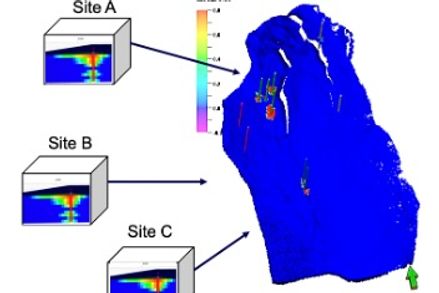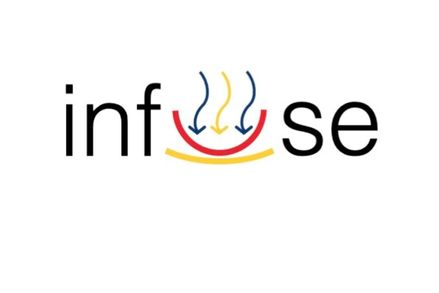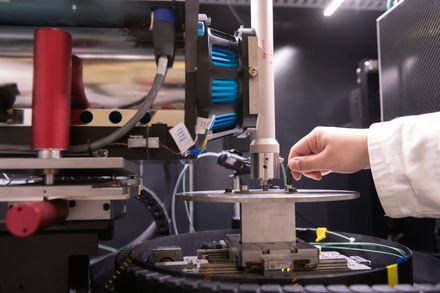Research
We investigate the physics, chemistry, and techno-economics of CO2 storage underground
Our research includes exploring fundamental pore scale fluid dynamics, developing digital rocks analysis techniques, increasing the accuracy of field scale reservoir simulation, and evaluating the feasibility of scaling up CO2 storage to climate relevant scales.
Our Research Projects
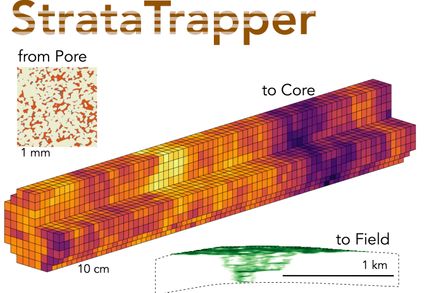
StrataTrapper Advanced Modelling of CO2 Migration and Trapping
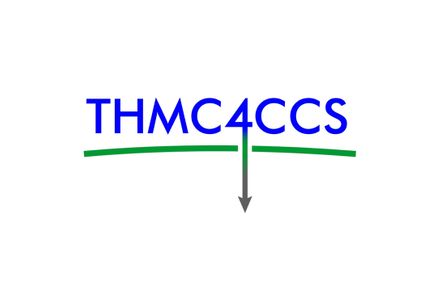
THMC4CCS: ThorougH experiMental and numerical investigation of Coupled processes for geologiC Carbon Storage
Results
- Showing results for:
- Reset all filters
Search results
-
Journal articleLindsay C, Braun E, Berg S, et al., 2023,
Core analysis in a changing world – how technology is radically benefiting the methodology to acquire, the ability to visualize and the ultimate value of core data
, Vol: 527, Pages: 43-58, ISSN: 0305-8719Core analysts principally study the storage, flow and saturation properties of porous rocks and sed-iments. Some of the derived parameters are specific to hydrocarbon production but many have commonality with other subsurface disciplines such as hydrology and soil science. Traditional core analysis involves direct physical experimentation on core plugs to derive a range of parameters used as calibration for conventional well logs, and to predict hydrocarbon reserves and recovery. The mechanisms and processes for obtaining such data have evolved significantly during the last century, from the manual instruments of the mid-twentieth century to the accredited digital data collection and recording of the 1990s onwards. X-ray micro-and nano-scale computed tomography (CT) imaging led to the development of the digital rock physics subdiscipline in the early 2000s. This has subsequently allowed direct visualization of fluid flow at the pore scale, imaging the wetting phase and multiphase fluid mobility. Multiscale imaging workflows are being developed to overcome issues around heterogeneous rock and the limited field of view associated with the high-est resolution X-ray CT images. Hybrid workflows, which combine digital rock physics with traditional core analysis, are becoming increasingly common to meet the challenges associated with some of the most difficult to constrain properties, such as relative permeability. At a larger scale, the recent development of multisensor core logging (MSCL) tools has allowed the cost-effective acquisition of essentially continuous high-resolution 1D, 2D and 3D datasets from both slabbed and unslabbed whole core. Often aided by artificial intelligence to manage and interpret these large physical and chemical datasets, both new and legacy core can be rapidly screened to allow representative subsampling for detailed laboratory experimentation. The context and data provided by the MSCL then allows effective upscaling of these time-and cost-int
-
Journal articleWu Y, An S, Tahmasebi P, et al., 2023,
An end-to-end approach to predict physical properties of heterogeneous porous media: Coupling deep learning and physics-based features
, FUEL, Vol: 352, ISSN: 0016-2361 -
Journal articleSpurin C, Roberts GG, O'Malley CPB, et al., 2023,
Pore-Scale Fluid Dynamics Resolved in Pressure Fluctuations at the Darcy Scale
, GEOPHYSICAL RESEARCH LETTERS, Vol: 50, ISSN: 0094-8276 -
Journal articleZhang Y, Jackson C, Darraj N, et al., 2023,
Feasibility of Carbon Dioxide Storage Resource Use within Climate Change Mitigation Scenarios for the United States
, ENVIRONMENTAL SCIENCE & TECHNOLOGY, Vol: 57, Pages: 14938-14949, ISSN: 0013-936X -
Journal articleKrevor S, de Coninck H, Gasda SE, et al., 2023,
Subsurface carbon dioxide and hydrogen storage for a sustainable energy future
, NATURE REVIEWS EARTH & ENVIRONMENT, Vol: 4, Pages: 102-118- Author Web Link
- Cite
- Citations: 19
-
Journal articleThaysen EM, Butler IB, Hassanpouryouzband A, et al., 2023,
Pore-scale imaging of hydrogen displacement and trapping in porous media
, INTERNATIONAL JOURNAL OF HYDROGEN ENERGY, Vol: 48, Pages: 3091-3106, ISSN: 0360-3199- Author Web Link
- Cite
- Citations: 6
-
Journal articleAndrews E, Muggeridge A, Jones A, et al., 2023,
Pore structure and wetting alteration combine to produce the low salinity effect on oil production
, Fuel: the science and technology of fuel and energy, Vol: 332, Pages: 1-15, ISSN: 0016-2361Low salinity water flooding is a promising enhanced oil recovery technique that has been observed, in experiments over a range of scales, to increase oil production by up to 14% in some systems. However, there is still no way of reliably predicting which systems will respond favourably to the technique. This shortcoming is partly because of a relative lack of pore scale observations of low salinity water flooding. This has led to a poor understanding of how mechanisms on the scale of micrometres lead to changes in fluid distribution on the scale of centimetres to reservoir scales. In this work, we use X-ray micro-CT scanning to image unsteady state experiments of tertiary low salinity water flooding in Berea, Castlegate, and Bunter sandstone micro-cores. We observe fluid saturations and characterise the wetting state of samples using imagery of fluid–solid fractional wetting and pore occupancy analysis. In the Berea sample, we observed an additional oil recovery of 3 percentage points during low salinity water flooding, with large volumes of oil displaced from small pores but also re-trapping of mobilised oil in large pores. In the Bunter sandstone, we observed 4 percentage point additional recovery with significant displacement of oil from small pores and no significant retrapping of oil in large pores. However, in the Castlegate sample, we observed just 1 percentage point of additional recovery and relatively small volumes of oil mobilisation. We observe a significant wettability alteration towards more water-wet conditions in the Berea and Bunter sandstones, but no significant alteration in the Castlegate sample. We hypothesise that pore structure, specifically the topology of large pores impacted recovery. We find that poor connectivity of the largest pores in each sample is strongly correlated to additional recovery. This work is the first systematic comparison of the pore scale response to low salinity flooding across multiple sandstone samples. Moreover
-
Journal articleZhang Y, Jackson C, Krevor S, 2022,
An estimate of the amount of geological CO2 storage over the period of 1996-2020
, Environmental Science and Technology Letters, Vol: 9, Pages: 693-698, ISSN: 2328-8930The climate impact of carbon capture and storage depends on how much CO2 is stored underground, yet databases of industrial-scale projects report capture capacity as a measure of project size. We review publicly available sources to estimate the amount of CO2 that has been stored by facilities since 1996. We organize these sources into three categories corresponding to the associated degree of assurance: (1) legal assurance, (2) quality assurance through auditing, and (3) no assurance. Data were found for 20 facilities, with an aggregate capture capacity of 36 Mt of CO2 year–1. Combining data from all categories, we estimate that 29 Mt of CO2 was geologically stored in 2019 and there was cumulative storage of 197 Mt over the period of 1996–2020. These are climate relevant scales commensurate with recent cumulative and ongoing emissions impacts of renewables in some markets, e.g., solar photovoltaics in the United States. The widely used capture capacity is in aggregate 19–30% higher than storage rates and is not a good proxy for estimating storage volumes. However, the discrepancy is project-specific and not always a reflection of project performance. This work provides a snapshot of storage amounts and highlights the need for uniform reporting on capture and storage rates with quality assurance.
-
Journal articleSpurin C, Rucker M, Moura M, et al., 2022,
Red Noise in Steady-State Multiphase Flow in Porous Media
, WATER RESOURCES RESEARCH, Vol: 58, ISSN: 0043-1397- Author Web Link
- Cite
- Citations: 4
-
Journal articleKeable D, Jones A, Krevor S, et al., 2022,
The effect of viscosity ratio and peclet number on miscible viscous fingering in a dele-shaw cell: a combined numerical and experimental study
, Transport in Porous Media, Vol: 143, Pages: 23-45, ISSN: 0169-3913The results from a series of well characterised, unstable, miscible displacement experiments in a Hele-Shaw cell with a quarter five-spot source-sink geometry are presented, with comparisons to detailed numerical simulation. We perform repeated experiments at adverse viscosity ratios from 1 to 20 and Peclet numbers from 104 to 106 capturing the transition from 2D to 3D radial fingering and experimental uncertainty. The open-access dataset provides time-lapse images of the fingering patterns, transient effluent profiles, and meta-information for use in model validation. We find the complexity of the fingering pattern increases with viscosity ratio and Peclet number, and the onset of fingering is delayed compared to linear displacements, likely due to Taylor dispersion stabilisation. The transition from 2D to 3D fingering occurs at a critical Peclet number that is consistent with recent experiments in the literature. 2D numerical simulations with hydrodynamic dispersion and different mesh orientations provide good predictions of breakthrough times and sweep efficiency obtained at intermediate Peclet numbers across the range of viscosity ratios tested, generally within the experimental uncertainty. Specific finger wavelengths, tip shapes, and growth are hard to replicate; model predictions using velocity-dependent longitudinal dispersion or simple molecular diffusion bound the fingering evolution seen in the experiments, but neither fully capture both fine-scale and macroscopic measures. In both cases, simulations predict sharper fingers than the experiment. A weaker dispersion stabilisation seems necessary to capture the experimental fingering at high viscosity ratio, which may also require anisotropic components. 3D models with varying dispersion formulations should be explored in future developments to capture the full range of effects at high viscosity ratio and Peclet number.
This data is extracted from the Web of Science and reproduced under a licence from Thomson Reuters. You may not copy or re-distribute this data in whole or in part without the written consent of the Science business of Thomson Reuters.




